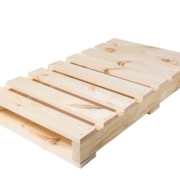Small Pallets Can Carry Huge Benefits

When it comes to the efficient handling of pallets, it makes sense that bigger should be better. Why move 100 cartons at a time when you can do 125? A larger pallet translates into more productive forklift handling. In the case of pallet selection, however, other factors can skew decision-makers toward smaller footprint pallets.
What is a Pallet Footprint?
To take a step back, the footprint of a pallet refers to its length and width. The pallet’s length is determined by the length of the stringer, or in the case of a block pallet, the length of the stringer board. The width of a pallet refers to the deck board length.
For a 48×40” stringer pallet, for example, the stringers are 48,” and the deck boards are 40”. In a 48×40” block pallet, the stringer boards, which lie between the deck boards and the blocks, are 48” and the deck boards are 40”.
What is a Fractional Pallet?
Small pallets can be fractional pallets such as half pallets and quarter pallets. They are fractional in the sense that they combine to become the equivalent of a full-size pallet. In North America, where the most popular pallet size is 48×40”, a half pallet is typically half of that measure.
To envision a half pallet, think of a full pallet that has been cut in half – either to 48×20” or 24×40”. Likewise, a quarter pallet is often 24×20” or 20×24”. Because fractional pallets can be combined to fill a standard pallet footprint, they readily integrate into supply chain transport and handling systems designed for standard full-size pallets.
What are the Benefits of Small Pallets?
Less touch labor at the warehouse and at retail. Half and quarter pallets permit the benefits of unit load shipping in smaller order quantities. Unit load shipment from a distribution center to the retailer translates into less touch labor for order pickers, resulting in improved productivity. Likewise, where the small pallet is displayed on the floor or positioned in-aisle, retail stocking activities can be largely eliminated.
Less product damages. According to one study, 80% of product damage in the FMCG supply chain takes place between the distribution center and retail. Because half or quarter pallet displays remain intact until they arrive at retail, the product damage associated with case picking, stacking and shelf stocking activities is avoided.
Sales boost on the retail floor. Evidence suggests that shoppers are drawn to floor displays, and as a result, they help boost sales. Small pallets can further enhance sales enabling more SKUs to be available to shoppers. Because small pallets take up less space, it is possible to increase the number of displays at a given time. Smaller pallets are also more shopper-friendly, eliminating the need to stretch across a full-size pallet to grab an item.
Easier navigation for shoppers and material handlers. Small pallets are better suited for delivering product through narrow doorways or in and out of backroom coolers with small openings. For deliveries to convenience stores, for example, the use of small pallets has been found to help reduce driver time at each stop. Small pallets also provide retailers with the opportunity to create displays that take up less space and therefore are more pedestrian-friendly.
Where they better fit product requirements. Small pallets also provide value where they conform to a particular product being shipped, thereby avoiding pallet underhang and wasted space (the product not utilizing the complete deck of the pallet).
More facings at the warehouse or assembly line. Because small pallets are not as wide as full pallets, more pallet facings can be created in the same distance, thus reducing travel time for assemblers.
What are the Disadvantages of Small Pallets?
Smaller payload. As mentioned above, half pallets hold only half as much product as full-size pallets. As a result, twice as many pallets are required, and twice as many unit loads must be handled to deal with the same amount of product.
Small pallets can add complexity. Small footprint unit loads can also pose challenges for material handlers. Some configurations may be more unstable than full pallets, requiring attention to mobile equipment operator training. Once emptied, small pallets must be sorted for return or otherwise recycled. Small pallets, especially non-fractional sizes, may be less desirable to pallet recyclers.
Benefits of small pallets aren’t applicable. While small pallets are becoming increasingly popular for retail display, they may not be applicable for many other supply chains.
The bottom line is that in some applications, such as retail, small pallet displays are helping retailers to boost sales and reduce stocking labor. No matter what size of pallet best meets your needs now or in the future, however, the good news is that pallet manufacturers can readily fabricate wood to produce the optimal size for your supply chain.

